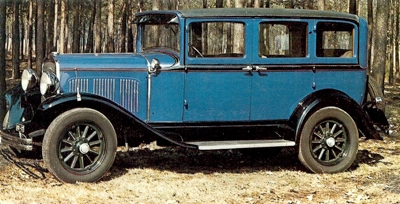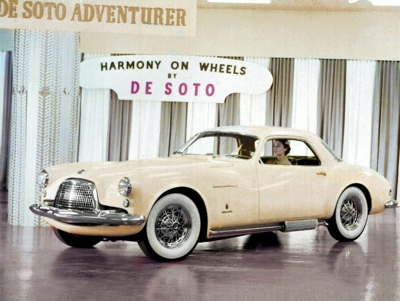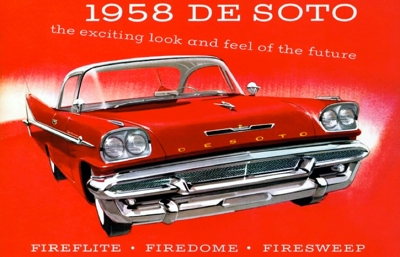IN 1928, WALTER CHRYSLER was riding high. After only four short years of manufacturing, he had risen to third place in the American motor industry, and he was ready to break into a new sector of the market.
A new 3.2-liter, side-valve six was designed to compete in a lower price range than the
Chrysler, selling under the marque name of De Soto. In general appearance, the De Soto resembled the contemporary Chryslers; its 21.6 hp engine was mounted on rubber insulators to reduce vibration, and had full force-feed lubrication.
There were hydraulic brakes on all four wheels and, from its chromium-plated ribbon-radiator to its rear-mounted spare wheel, the De Soto represented the most up-to-date motor-engineering practice. That price was reportedly under $500 for a two- seater with wood wheels; the success of the venture was shown by first-year sales of around 90,000.
A second De Soto model appeared in 1930, a 3.5-liter straight-eight, which was the lowest priced eight-cylinder car in the world. The bodies were bolted to the chassis to form a rigid unit, and among the standard features were Lockheed four-wheel hydraulic brakes and a downdraught carburetor.
However, the depression hit the De Soto's market hard. Sales dropped to 26,000 in 1932, even though the cars were probably better value than ever. The De Soto name vanished from most export markets around 1931 and, during the 1930s, cars which were sold as De Sotos in the US would be sold under the Chrysler name overseas.
The 1933 De Sotos (sold as the 20/63 hp Chrysler Richmond and Mortlake in some export markets) featured all the Chrysler innovations like two-point 'floating power' engine-suspension, a double-drop girder truss chassis, and a three-speed manual transmission.
In 1934 De Sotos followed the
Chrysler Airflow line with a 4-liter, six-cylinder model, sold in export markets as the Croydon. However, this appeal to the air-minded went largely unheeded and, for 1936, a more conventional, V-bonnetted styling was adopted.
Overdrive was an option on the De Soto Airflows, and later became available on the conventional models as well. Unusual for US cars, 12-volt lighting and starting systems were used. 1936 saw a swing away from the Airflow look, and the adoption of a vertical dummy radiator grill and a rear-hinged alligator bonnet.
By 1939, the cars had acquired independent front suspension and a steering-column gear-shift, as well as a choice of two six-cylinder power units. In 1941, the Vacumatic, semi-automatic transmission became available as an option. After World War 2 the De Soto line gained the full-width 'dollar grin' styling fashionable among US cars. The first really new models appeared in 1949, when there were two ranges, the S14 de luxe and custom with 236.7 cu in, Lvhead, six-cylinder engines and the smaller SP20 Diplomat for export only.
Custom models featured, as standard, Tip-Toe hydraulic gear shifting, in conjunction with Gyrol Fluid Drive; this was optional on the de luxe versions. Apart from revised styling, the 1951 range was broadly similar, though the stroke was enlarged, increasing the swept volume to 250.6 cubic inches.
Series S17 Firedome V8
The 1952 range was little changed, except for the addition of the new Series S17 Firedome V8 'hemi-head' engine. By 1953, the new V8s were outselling the old sixes, by around two-to-one. The power output of the V8 was boosted from 160 to 170 bhp in 1954, and the Firedome was now selling seventy per cent of total De Soto production. In 1955 there was a shake-up in the De Soto range, which, once again, underwent styling changes.
 1928 De Soto Six, which featured a 3.2 liter engine.
1928 De Soto Six, which featured a 3.2 liter engine.
 1953 De Soto Adventurer.
1953 De Soto Adventurer.
 1958 De Soto Fireflite.
1958 De Soto Fireflite. |
A new, higher-priced version of the Firedome, the S21 Fireflite, was announced; though it had the same chassis and 291-cubic inch V8 engine as the Firedome, its power output was 200 bhp against the older model's 185.
Now, only export markets could buy the six- cylinder De Soto, being made available on some Diplomat models, while the S26 Diplomat and Diplomat custom were based on the Plymouth Six Plaza and Belvedere.
Flight Sweep Styling and The Adventurer
The new look 'flight sweep' styling was adopted on all Chrysler models and resulted in an upswing in the group's sagging sales; De Soto, it seems, benefited less than Chrysler and Plymouth. For 1956, a new top-of- the-range model, the Adventurer, was introduced.
The S24 Fireflite range featured push-button automatic transmission as standard; this was an option on the S23 Firedome models. The Diplomat models for 1956 had a choice of 125 bhp, six-cylinder Power-Flow or 187 bhp, V8 Hy-Fire power units, with a less potent V8 available in export markets.
In the following year, Diplomats acquired the option of overdrive and Power Flite automatic transmission, while the Diplomat Custom V8 featured Torque Flite automatic transmission. However, the success of the 1957 season was the new lower priced FireSweep V8 range which, by the end of the year, represented 35 per cent of the marque's total production.
The 1958 economic downturn hurt sales of mid-priced makes across the board, and DeSoto sales were 60 percent lower than those of 1957 in what would be DeSoto's worst year since 1938. The sales slide continued for 1959 and 1960 (down 40 percent from the already low 1959 figures), and rumors began to circulate DeSoto was going to be discontinued.
De Sotos were also becoming more and more like their Plymouth brethren, a fact which was realised by the formation of the Plymouth-De Soto division of the Chrysler corporation in 1959. By the time the 1961 DeSoto was introduced in the fall of 1960, rumors were widespread that Chrysler was moving towards terminating the brand, fueled by a reduction in model offerings for the 1960 model year.
The introduction of the value priced Chrysler Newport, a brand with more upscale market appeal, no doubt hastened the decision to end production of DeSoto, which was very similar in size, styling, price, and standard features. For 1961, DeSoto lost its series designations entirely, in a move reminiscent of Packard's final lineup. And, like the final Packards, the final DeSoto was of questionable design merit. Again, based on the shorter Chrysler Windsor wheelbase, the DeSoto featured a two-tiered grille (each tier with a different texture) and revised taillights. Only a two-door hardtop and a four-door hardtop were offered. The cars were trimmed similarly to the 1960 Fireflite.
The final decision to discontinue DeSoto was announced on November 30, 1960, just forty-seven days after the 1961 models were introduced. At the time, Chrysler warehouses contained several million dollars in 1961 DeSoto parts, so the company ramped up production in order to use up the stock. Chrysler and Plymouth dealers, which had been forced to take possession of DeSotos under the terms of their franchise agreements, received no compensation from Chrysler for their unsold DeSotos at the time of the formal announcement. Making matters worse, Chrysler kept shipping the cars through December, many of which were sold at a loss by dealers eager to be rid of them. After the parts stock was exhausted, a few outstanding customer orders were filled with Chrysler Windsors. Yet another famous motoring name passed into history.
